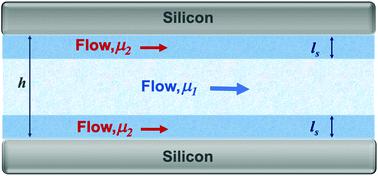Our official English website, www.x-mol.net, welcomes your
feedback! (Note: you will need to create a separate account there.)
On interfacial viscosity in nanochannels.
Nanoscale ( IF 5.8 ) Pub Date : 2020-06-12 , DOI: 10.1039/d0nr02294b Masoumeh Nazari 1 , Ali Davoodabadi , Dezhao Huang , Tengfei Luo , Hadi Ghasemi
Nanoscale ( IF 5.8 ) Pub Date : 2020-06-12 , DOI: 10.1039/d0nr02294b Masoumeh Nazari 1 , Ali Davoodabadi , Dezhao Huang , Tengfei Luo , Hadi Ghasemi
Affiliation

|
Capillary driven transport of liquids in nanoscopic channels is an omnipresent phenomenon in nature and technology including fluid flow in the human body and plants, drug delivery, nanofluidic devices, and energy/water systems. However, the kinetics of this mass transport mechanism remains in question as the well-known Lucas–Washburn (LW) model predicts significantly faster flow rates compared to the experimental observations. We here showed the role of interfacial viscosity in capillary motion slowdown in nanochannels through a combination of experimental, analytical and molecular dynamics techniques. We showed that the slower liquid flow is due to the formation of a thin liquid layer adjacent to the channel walls with a viscosity substantially greater than the bulk liquid. By incorporating the effect of the interfacial layer, we presented a theoretical model that accurately predicts the capillarity kinetics in nanochannels of different heights. Non-equilibrium molecular dynamics simulation confirmed the obtained interfacial viscosities. The viscosities of isopropanol and ethanol within the interfacial layer were 9.048 mPa s and 4.405 mPa s, respectively (i.e. 279% and 276% greater than their bulk values). We also showed that the interfacial layers are 6.4 nm- and 5.3 nm-thick for isopropanol and ethanol, respectively.
中文翻译:

关于纳米通道中的界面粘度。
毛细管驱动的液体在纳米通道中的传输是自然界和技术界普遍存在的现象,包括人体和植物中的流体流动,药物输送,纳米流体设备以及能源/水系统。但是,这种大众运输机制的动力学仍存在疑问,因为众所周知的卢卡斯-沃什本(LW)模型预测的流速比实验观察的要快得多。我们在这里通过结合实验,分析和分子动力学技术显示了界面粘度在纳米通道中毛细管运动减慢中的作用。我们表明,较慢的液体流动是由于在通道壁附近形成了一层稀薄的液体层,其粘度明显大于散装液体。通过结合界面层的作用,我们提出了一种理论模型,可以准确预测不同高度的纳米通道中的毛细动力学。非平衡分子动力学模拟证实了所获得的界面粘度。界面层中异丙醇和乙醇的粘度分别为9.048 mPa s和4.405 mPa s(即分别比其体积值高279%和276%)。我们还表明,对于异丙醇和乙醇,界面层的厚度分别为6.4 nm和5.3 nm。
更新日期:2020-07-16
中文翻译:

关于纳米通道中的界面粘度。
毛细管驱动的液体在纳米通道中的传输是自然界和技术界普遍存在的现象,包括人体和植物中的流体流动,药物输送,纳米流体设备以及能源/水系统。但是,这种大众运输机制的动力学仍存在疑问,因为众所周知的卢卡斯-沃什本(LW)模型预测的流速比实验观察的要快得多。我们在这里通过结合实验,分析和分子动力学技术显示了界面粘度在纳米通道中毛细管运动减慢中的作用。我们表明,较慢的液体流动是由于在通道壁附近形成了一层稀薄的液体层,其粘度明显大于散装液体。通过结合界面层的作用,我们提出了一种理论模型,可以准确预测不同高度的纳米通道中的毛细动力学。非平衡分子动力学模拟证实了所获得的界面粘度。界面层中异丙醇和乙醇的粘度分别为9.048 mPa s和4.405 mPa s(即分别比其体积值高279%和276%)。我们还表明,对于异丙醇和乙醇,界面层的厚度分别为6.4 nm和5.3 nm。











































 京公网安备 11010802027423号
京公网安备 11010802027423号